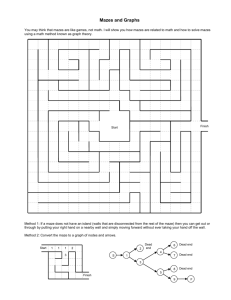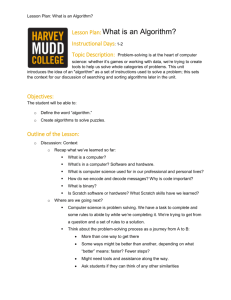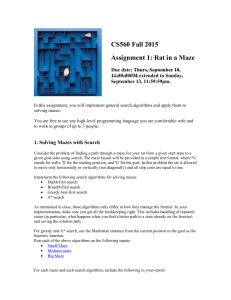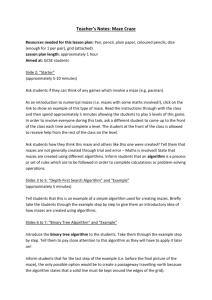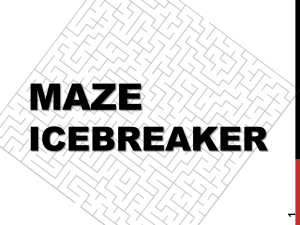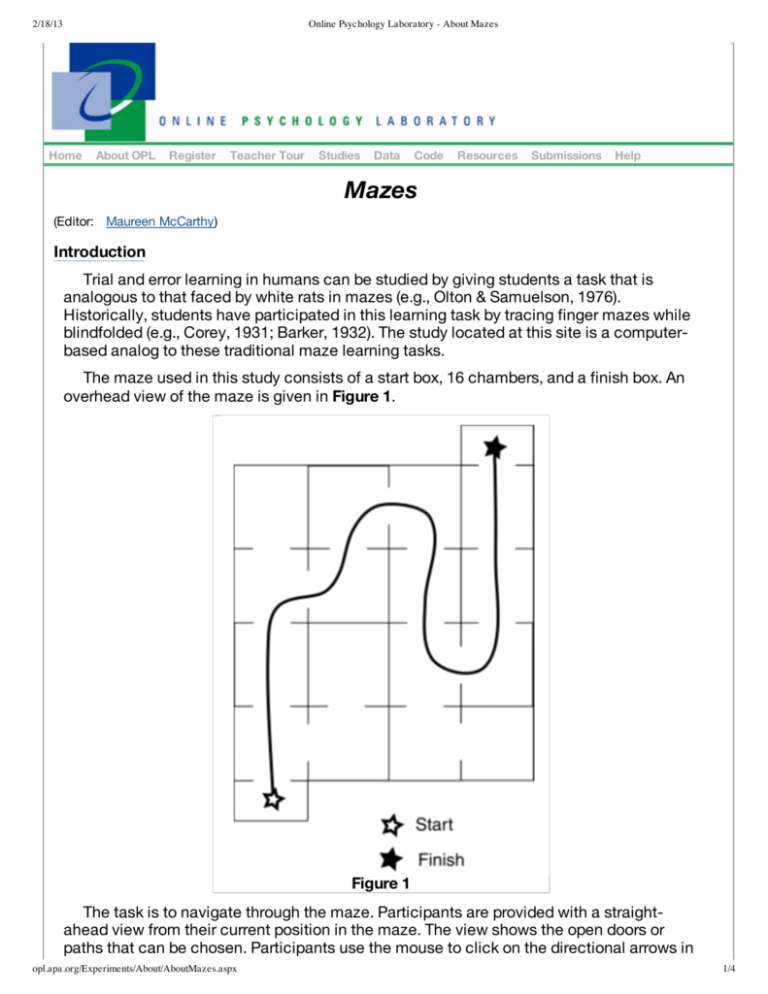
2/18/13
Online Psychology Laboratory - About Mazes
Home
About OPL
Register
Teacher Tour
Studies
Data
Code
Resources
Submissions
Help
Mazes
(Editor: Maureen McCarthy)
Introduction
Trial and error learning in humans can be studied by giving students a task that is
analogous to that faced by white rats in mazes (e.g., Olton & Samuelson, 1976).
Historically, students have participated in this learning task by tracing finger mazes while
blindfolded (e.g., Corey, 1931; Barker, 1932). The study located at this site is a computerbased analog to these traditional maze learning tasks.
The maze used in this study consists of a start box, 16 chambers, and a finish box. An
overhead view of the maze is given in Figure 1.
Figure 1
The task is to navigate through the maze. Participants are provided with a straightahead view from their current position in the maze. The view shows the open doors or
paths that can be chosen. Participants use the mouse to click on the directional arrows in
opl.apa.org/Experiments/About/AboutMazes.aspx
1/4
2/18/13
Online Psychology Laboratory - About Mazes
order to choose their path. For example, Figure 2 shows the view from the start box. Note
that there are just two directional options active (straight ahead and right) from the start
box. On subsequent choices, only viable options are active. When participants reach a
dead end, the only active choice will be a backward movement.
Figure 2
Design
There are two dependent measures for this study. Timing is the first measure and
reflects the elapsed time for completion of the maze. If participants return to the start box
before entering the finish box, the timing is not restarted.
The second dependent variable is error. The numbers of errors are recorded during
each trial. Each time an incorrect movement, which results in a deviation from the correct
path is made, it counts as one error. Each subsequent movement along that incorrect
path is not counted as an additional error.
The experiment requires that participants complete the maze 15 times. Data can be
plotted for each of the 15 trials and should reflect a decrease in the time to complete the
maze.
Data can also be aggregated. Typical learning studies average a series of trials into
one block. In experimental design, a "blocking variable" is used to capture unwanted
variance from a nuisance variable. The term "block" in this study refers simply to a set of
trials. Choice of block size is simply a matter of desired resolution. In the study of human
and animal learning, block sizes of 1 (i.e., trial by trial report) are apt to produce jagged
learning curves. Block sizes that are too large may miss an important temporal aspect to
learning. So the trick is to find a proper block size. We have used 3 and that seems to work
quite well. These blocks can then be plotted and the resulting graph produces a smoother
representation of learning. In this study, it would be appropriate to average trials in groups
of 3 and this would result in 5 data points.
Data Format and Download
opl.apa.org/Experiments/About/AboutMazes.aspx
2/4
2/18/13
Online Psychology Laboratory - About Mazes
Data are downloadable in three formats (XML, Excel spreadsheet format, and comma
delimited for statistical software packages like SPSS). Definitional information for each of
the labeled columns are shown in Figure 3.
Figure 3
The first column provides the participant ID number. The third column provides the
class ID for which a participant's data is affiliated. Gender (column 2) and age (column 4)
are self-explanatory. The date of participation is located in column five. Columns labeled
T1T-T15T reflect time for completion of trials 1-15. Columns labeled T1E-T15E reflects
errors for completion of the maze for trials 1-15.
Data Analyses
In this repeated trials study, it would be appropriate to conduct a repeated measure
ANOVA for time and/or errors in the maze task. The ANOVA can be conducted using all 15
trials or the 5 suggested blocks.
Applications and Extensions
This study can be used to illustrate classic learning experiments in which rats or people
explore novel situations and make decisions based on stimuli that produce desired
outcomes. Early learning studies were conducted at the basic level of analysis and
provided a foundation for cognitive processing (see Hilgard, 1948). Newer models suggest
that learning is multifaceted and may be influenced by multiple factors (Ahsen, 2000).
Nevertheless, analyses of the results of this study provide students with understanding of
the basic elements or building blocks of cognition.
References
Ahsen, A. (2000). Image and maze: Learning through imagery functions. Journal of Mental Imagery, 24(1 &2), 1­60.
Barker, R. G. (1932). Factors influencing transfer between finger mazes. Journal of General Psychology, 6, 115­132.
Corey, S. M. (1931). An inexpensive finger maze. American Journal of Psychology, 43, 502.
Hilgard, E. R. (1948). Theories of learning. New York: Appleton­Century­Croft.
Olton, D. S., & Samuelson, R. J. (1976). Remembrance of places passed: Spatial memory in rats. Journal of Experimental Psychology: Animal Behavior Processes, 2, 97­115.
opl.apa.org/Experiments/About/AboutMazes.aspx
3/4
2/18/13
Online Psychology Laboratory - About Mazes
Contact Us
Privacy Policy
In association with:
National Science Foundation, National Science Digital Library, American Psychological Association Education Directorate.
All materials on this site are protected by United States Copyright Law and may not be reproduced, distributed, transmitted, published or broadcast
without prior written permission. You may not alter or remove any trademark, copyright, or other notice from copies of the content. The OPL web site
managed by the OPL Advisory Board and materials remain the property of the authors. All Rights Reserved. Funding provided by the National Science
Foundation [DUE ­ 0435058]
opl.apa.org/Experiments/About/AboutMazes.aspx
4/4

